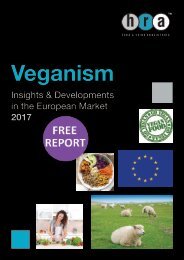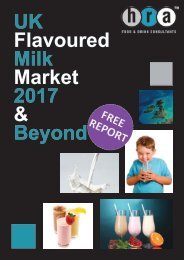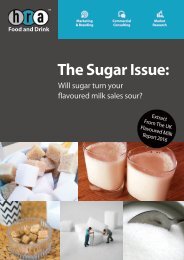FREE-UK-Flavoured-Milk-Report-2016-2017
The backdrop to the UK flavoured milk market is one of relentless change. The removal of the EU milk quotas, the transition to a Western-type diet by emerging economies, the UK sugar debate and the booming sports nutrition industry are all aspects of change that create both challenges and opportunities for the UK flavoured milk market. HRA Food and Drink Marketing has developed this report as a map to guide industry stakeholders. Although volume growth in 2014 was slightly lower than in previous years, the flavoured milk market still has plenty of room for product innovation and development. Overall, we expect the UK flavoured milk market to continue to grow over the medium term, but not without improving its nutritional profile. The sugar debate reached new heights when, in October 2015, Public Health England released a document suggesting Government intervention in the form of a sugar tax (levy). As a consequence, product reformulation has become a priority for all serious players in the market.
The backdrop to the UK flavoured milk market is one of relentless change. The removal of the EU milk quotas, the transition to a Western-type diet by emerging economies, the UK sugar debate and the booming sports nutrition industry are all aspects of change that create both challenges and
opportunities for the UK flavoured milk market.
HRA Food and Drink Marketing has developed this report as a map to guide industry stakeholders. Although volume growth in 2014 was slightly lower than in previous years, the flavoured milk market still has plenty of room for product innovation and development.
Overall, we expect the UK flavoured milk market to continue to grow over the medium term, but not without improving its nutritional profile. The sugar debate reached new heights when, in October 2015, Public Health England released a document suggesting Government intervention in the form of a sugar tax (levy). As a consequence, product reformulation has become a priority for all serious players in the market.
You also want an ePaper? Increase the reach of your titles
YUMPU automatically turns print PDFs into web optimized ePapers that Google loves.
<strong>UK</strong>#FLAVOURED#MILK#<strong>2016</strong>217#<br />
#<br />
4.! The Power Categories<br />
Our working segmentation sees the flavoured milk market divided into six<br />
‘power categories’. This chapter looks at each of these power categories in<br />
turn: traditional flavoured milk, functional drinks, coffee, confectionary,<br />
breakfast and alternative flavoured milk.<br />
The percentages beside the categories give an approximate indication of the<br />
relative weighting of the categories sales to the <strong>UK</strong> flavoured milk market as<br />
a whole.<br />
To Gain Access<br />
Purchase The Full<br />
<strong>Report</strong> Now<br />
Figure 4-1: The Power Categories<br />
For each category, we explore the two flagship brands featured in the<br />
pyramid above and examine products, advertising, marketing and financials.<br />
Traditional <strong>Flavoured</strong> <strong>Milk</strong><br />
#<br />
Traditional milk laid the foundations for the flavoured milk category and is the<br />
biggest sub-category in volume sales with our estimate being that it is just<br />
under half of the category. In To its most Gain simple Access form, it is milk with added<br />
sugar and natural or artificial Purchase flavours. Traditional The Full flavoured milk products<br />
have been available in <strong>UK</strong> supermarket aisles for over two decades in their<br />
<strong>Report</strong> Now<br />
present form and are usually found alongside white liquid milk with typical<br />
flavours including chocolate, strawberry, vanilla and banana.<br />
© <strong>2016</strong> Teepee Limited. All Rights Reserved.<br />
57







